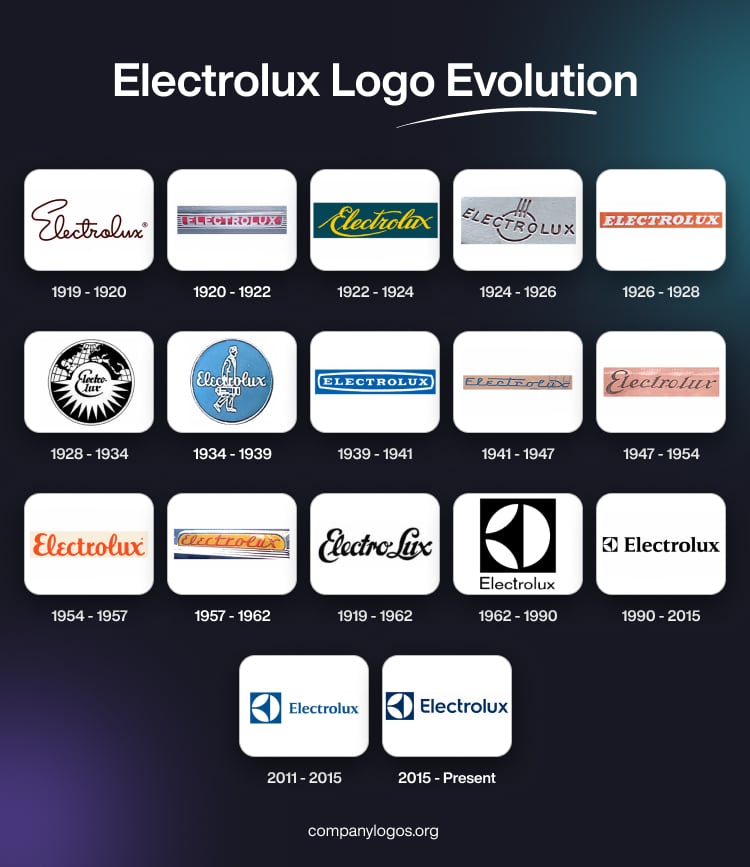
Electrolux AB is a leading Sweden-based multinational company that produces home appliances. Recognised globally for its innovative and reliable products, Electrolux was founded in 1919 through the merger of Lux AB and Svenska Elektron AB. The wide product portfolio of Electrolux includes refrigerators, washing machines, ovens, vacuum cleaners, and small kitchen appliances. The company operates in more than 150 countries and is known for combining Scandinavian design principles with advanced technology.
The Electrolux logo has undergone several changes since its inception, and each of these logo iterations reflects the growth of the company from a Swedish vacuum cleaner manufacturer to a global home appliance leader. The article explores the evolution of the Electrolux logo over the years, among other details of the company.
The Genesis of the Electrolux Logo (1919 – 1920)
The original Electrolux logo was a handwritten inscription depicting the brand name. It was written in cursive style without any line breaks, where each letter was connected to the subsequent one. Written in dark brown colour, the inscription had a lot of loose twists, especially with the letters “E”, “l”, and “t”.
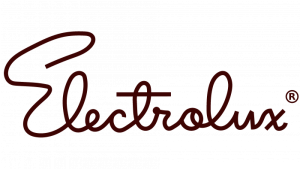
(1920 – 1922)
The 1920 logo iteration featured the brand name written in a metallic-looking, bold, geometric sans-serif typeface in uppercase against a red horizontal rectangular background.
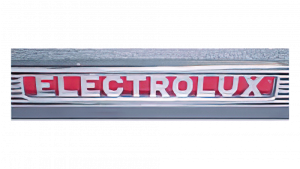
(1922 – 1924)
The 1922 logo variant featured a more uniform, yet italicised, cursive-styled inscription in a title case. The yellow-coloured lettering was placed against a dark blue rectangular background. A few letters of the logotype had curved and elongated lines, such as “E”, “t”, and “x”.
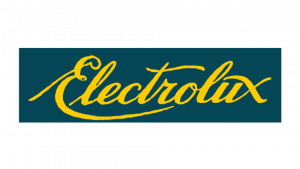
(1924 – 1926)
In 1924, the Electrolux logo in brown featured a graphical emblem along with the brand name. Consisting of a circle, the emblem at the centre had three even stripes drawn vertically at the top. The uppercase lettering was executed in a curved sans-serif typeface.
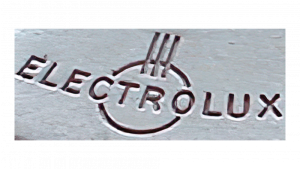
(1926 – 1928)
The 1926 logo variant appeared in a white printed inscription in uppercase written using a classic serif typeface. The lettering was placed on a horizontal red rectangle.
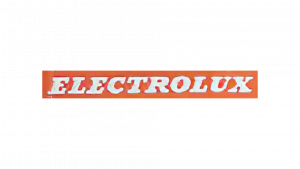
(1928 – 1934)
The 1928 logo consisted of a black-and-white circle with a thin black and white outline. The upper part of the circle featured a portion of the world map along with the grid. The centre and lower portions of the circle had the brand name written on two levels using a cursive typeface in black. The brand name was set against a small circle resembling the sun in white with protruding rays, also in white, spread in different directions.
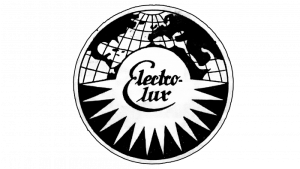
(1934 – 1939)
The 1934 logo featured a blue circular emblem with two white elements. One of the white elements was the stylised image of a buyer drawn sideways carrying a vacuum cleaner from right to left. The other element in white was the brand name “Electrolux” written in cursive letters in italics.
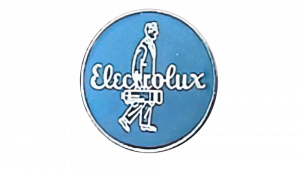
(1939 – 1941)
The next logo iteration in 1939 saw the brand name in uppercase written using a bold serif typeface in white. Each letter of the brand name had adequate spacing, and the brand name was surrounded by a white stretched rectangle with a convex top and bottom. Further, both the lettering and the white outline were placed inside a blue rectangle.
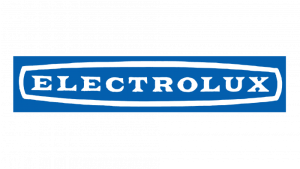
(1941 – 1947)
The 1941 logotype in blue was written in a title case, and each letter was joined together at the base by a single line. Also, the horizontal bar of the letter “t” and the upper crossbar of the letter “x” were extended. The background of the logo was light brown.
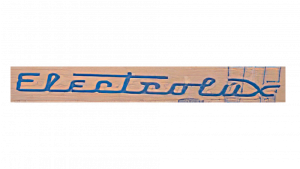
(1947 – 1954)
The 1947 logo comprised a brown cursive wordmark with delineated letters. Most letters stood separately from each other, except for the interconnectedness of “lec” and “lux”. Besides, the letters “t” and “l” had pointed tops.
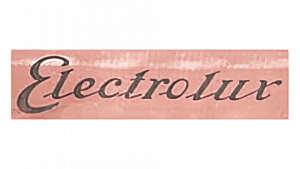
(1954 – 1957)
The 1954 logo saw a rounded handwritten inscription in red where every letter was joined at the bottom through the curves. Also, there was a small red square dot on top of the letter “x”.
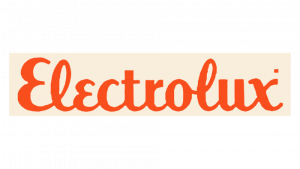
(1957 – 1962)
In this logo iteration, the previous logo was repeated, except for the fact that the inscription was made more linear and slanted and included a shared line at the bottom. However, the red inscription was placed in a horizontally stretched oval in yellow.
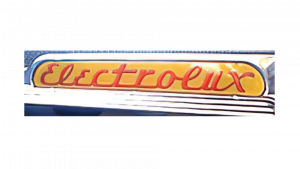
(1919 – 1962)
This visual identity introduced a new logotype where the brand name in black and set against a white background was split into two parts – capitalised “E” and “L”. The logotype was written using a smooth typeface with curved lines and softened angles.
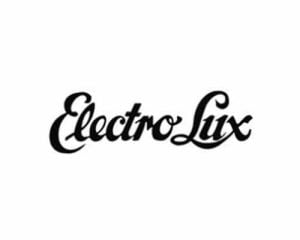
(1962 – 1990)
The 1962 logo came with a graphical emblem and a wordmark in black and white. The emblem consisted of a bold black square containing a white circle inside. Inside the circle was placed a stylised image of a three-pointed star. The wordmark below the emblem was written in a title case using a thin traditional serif typeface. Interestingly, the graphical emblem became a part of the subsequent logo editions as well.
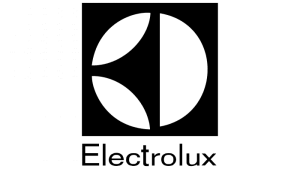
(1990 – 2015)
The 1990 logo saw the logo elements being swapped and changed in scale. For instance, the graphical emblem, as depicted in the previous iteration, was made smaller, while the brand name was enlarged by adding serifs.

(2011 – 2015)
In this iteration, the scale of the graphical emblem was increased at the cost of the wordmark. The logo in blue had the wordmark written in a classy serif typeface with sharp ends.
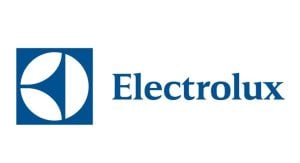
(2015 – Present)
The present logo retains the previous one and features the brand name in a new, modern and custom typeface called the Electrolux Sans. The typeface appears in Semibold, Regular, and Light variants. Besides, the stylish letters of the brand name had rounded angles and the wordmark was either placed to the right or bottom of the emblem.
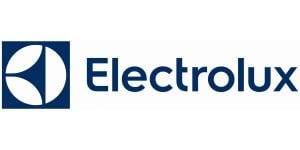
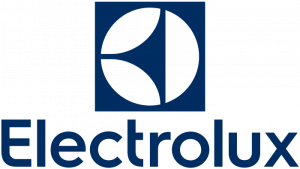
The Elements of the Electrolux Logo
Font
The logotype used in the Electrolux logo is written using a custom typeface called Electrolux Sans, which has been modified from the Hurme Geometric Sans No 2 typeface. The logo appears in three font variants – regular, light, and bold.
Colour
The Electrolux logo is depicted in two colours – navy blue and white.
The History of Electrolux
The history of Electrolux can be traced back to 1919, when the Swedish company Lux AB, a manufacturer of kerosene lamps, entered into a partnership with Svenska Elektron AB to form Elektrolux. The name was later standardised as Electrolux in 1957. The company initially focused on manufacturing vacuum cleaners but quickly expanded into manufacturing refrigerators during the 1920s. It thus set the foundation for its future as a major household appliance producer.
Through the mid-20th century, Electrolux diversified into manufacturing washing machines, dishwashers, and other home essentials and steadily built a reputation for practical and reliable products. The post-war era marked rapid global expansion, as the company established a strong presence across Europe and beyond. From the 1960s onwards, Electrolux grew significantly through acquisitions by acquiring well-known brands such as Zanussi, AEG, Frigidaire, Eureka, and Westinghouse appliances. These acquisitions helped broaden its product portfolio and market reach.
By the late 20th century, it had become one of the world’s leading appliance manufacturers. In recent decades, Electrolux has placed increasing emphasis on sustainability, energy efficiency, and design innovation. It continues to operate in more than 150 countries and stands as a global household name. It is known for blending Scandinavian design principles with modern technology to create appliances that improve everyday living.
Interesting Facts About Electrolux
- Electrolux was founded in Stockholm, Sweden, in 1919 by Axel Wenner-Gren. It initially focused on making vacuum cleaners lighter and more user-friendly.
- The company quickly diversified and introduced the world’s first absorption refrigerator in 1925. In 1951 and 1959, it expanded to manufacturing washing machines and dishwashers, respectively.
- In 1921, it launched the Model V vacuum cleaner, which weighed only five kilograms and had runners. It made it easier to move compared to the heavier models of the era.
- In 1940, Electrolux introduced the “Assistent” food processor. Designed for home use, this became known for its durability and iconic design.
- Electrolux was a pioneer in smart home technology. It launched the world’s first robotic vacuum cleaner, the Trilobite, in 1997. Again, in 1999, it introduced an internet-connected refrigerator with advanced features.
- The company expanded its reach globally through strategic acquisitions, which included Zanussi, AEG, and White Consolidated Industries.
- Electrolux has played a significant role in household transformation. This is more so due to the introduction of the washing machine, which had a profound impact on daily life and women’s roles in society.
- The brand is committed to sustainability and is consistently recognised worldwide for its efforts to lead in environmentally responsible practices.
- Early financial milestones highlight the company’s rapid growth. These milestones include widespread international sales and public offerings in both London and Stockholm by the late 1920s.
- Historical innovations in industrial design, such as the Model 30 vacuum cleaner launched in 1937 and the continuing legacy of stylish, reliable products, have made Electrolux a household name for over a century.
Finally
The evolution of the Electrolux logo shows how the company grew to attain its status as a modern, globally recognised brand. The logo chain started with ornate and script-style marks in the early 20th century and gradually simplified its identity to match the changing design sensibilities of each era. The most defining moment came in 1961–62, when Swiss designer Carlo L. Vivarelli introduced the bold circular emblem.
It was a timeless, geometric design that symbolised motion, innovation, and modernity. This mark became the cornerstone of Electrolux’s visual identity and provided consistency and recognition across decades of expansion and diversification. The Electrolux logo stands as a perfect example of how a company can evolve its visual identity by balancing tradition with innovation.